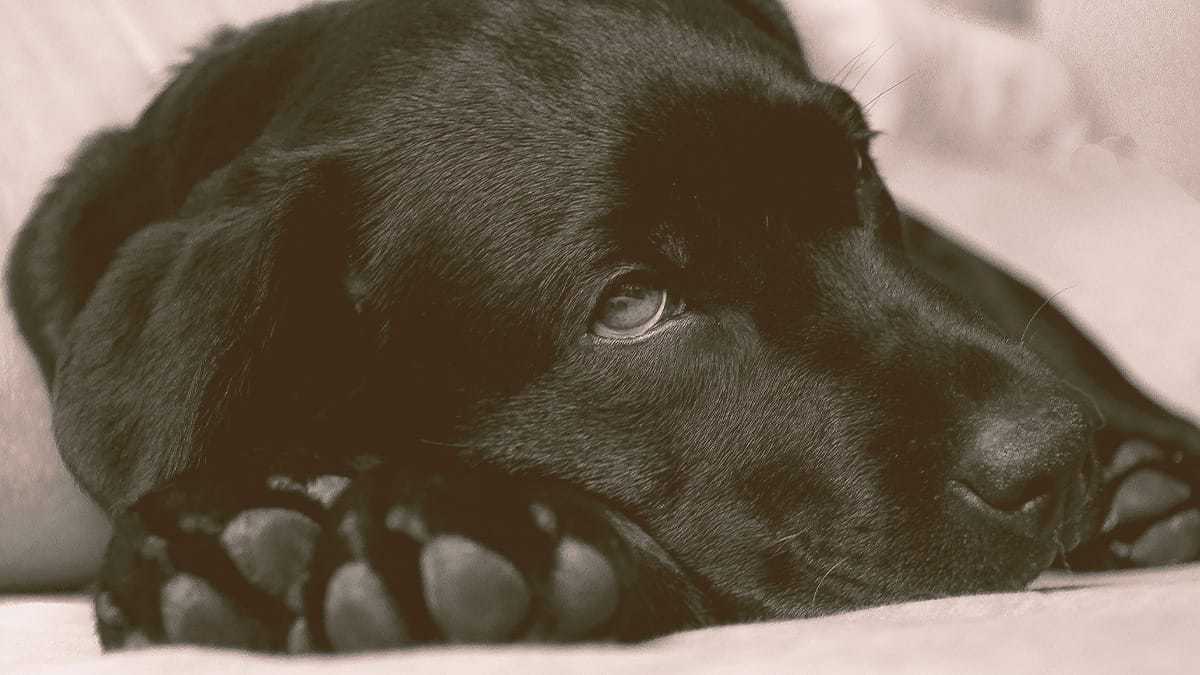
Dog Diarrhea: Symptoms, Causes, Treatments & Home Remedies
Alex Vicente • Updated on August 22, 2023
- This review contains affiliate links. Read more here.
- Not a substitute for professional veterinary help.
Seasoned dog owners know all too well that when it comes to doggy diarrhea, it’s a matter of when, not if their dog will succumb.
It’s not the most pleasant topic, but it is vital to understand if you want to ensure you have a happy, healthy dog for many years.
I’ve dealt with this issue in my dogs, which is unpleasant, but there are several ways to limit the severity and length.
Table of Contents
What is Dog Diarrhea?
Dog diarrhea, also called gastrointestinal distress or doggy runs, is not an illness in itself, but rather one sign of another type of disease ranging from food poisoning to cancer. We characterize dog diarrhea as loose, watery stools. You may notice that your dog has accidents inside the house or needs to go out more frequently and urgently during a bout of diarrhea.
It’s essential to note that you will probably not be able to stop diarrhea in your dog completely. Dogs are walking garbage disposals, and although their digestive systems can handle a lot, there will likely come a time when your dog eats something that bothers the digestive tract a bit too much, and diarrhea will ensue.
If diarrhea is the only symptom you see in your dog, then it’s unlikely that you’re dealing with a severe problem. In that case, you can act quickly to take care of the dog’s needs without necessitating medical treatment.
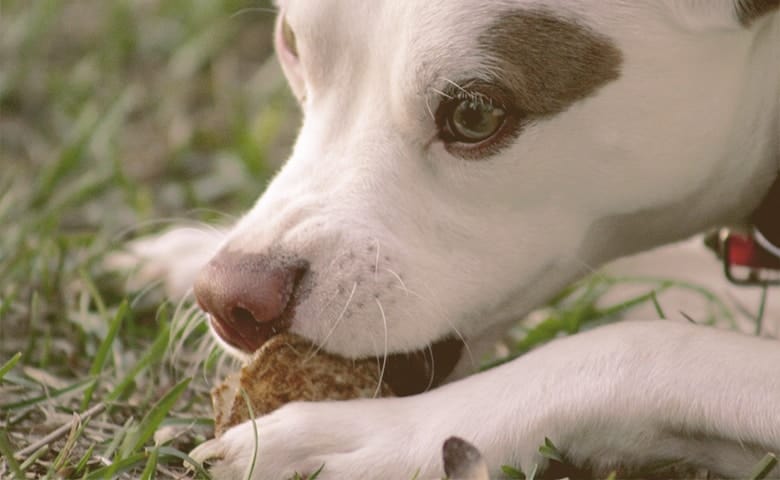
Causes of Diarrhea in Dogs
As a dog owner, I know that when I think of diarrhea in my dogs, I think of all of the nonsense they eat when I turn my back. We live in a rural area, and we will go for walks through fields or pastures with the dogs. More often than not, I’ll catch a dog nose deep in a pile of something else’s poop or the rotting carcass of a small animal before I can react.
Fortunately, dog digestive systems are on point, but they can’t process all of the bad stuff all of the time, causing diarrhea. A dog’s digestive system starts in the mouth where the saliva kills bacteria that could harm the dog. Then, in the stomach, acids that are three times more powerful than human stomach acid do most of the digesting.
When a dog eats something that has too much bacteria for the saliva to handle or is too difficult to process in the stomach, then it can lead to diarrhea. The technical term for eating in this way is dietary indiscretion. It means that your dog doesn’t care what’s in front of him if he’s hungry or something smells good, he’s going to eat it.
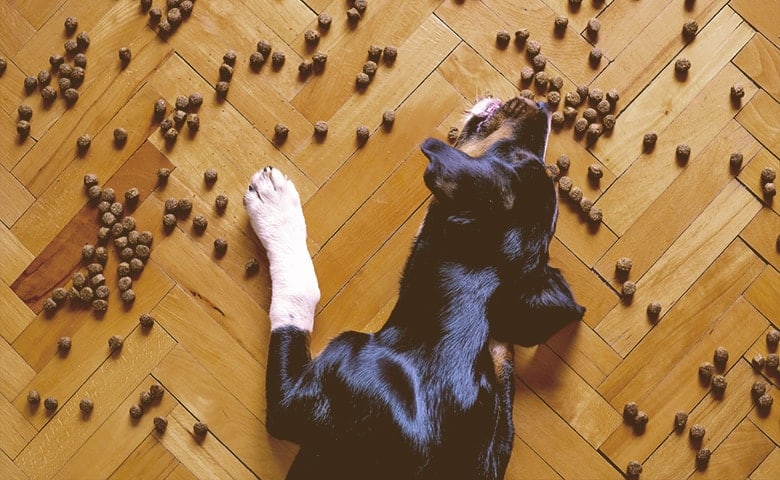
Changes in Diet
When you change your dog’s food, even if you’re changing to a better or less processed food source, you need to do it slowly so that your dog’s system can have a chance to adjust. If you transition them too quickly, then you are asking for tummy troubles that can lead to diarrhea or vomiting. It’s well worth the week or two of transitioning correctly to avoid the gross side effects.
Food Intolerance
You’ve probably seen lists of human foods that you shouldn’t allow your dog to eat. One well-known example is chocolate. Dogs can handle a lot, but certain foods can shut down their systems and make them very sick. Avoiding foods like chocolate, onions, grapes, and others that they don’t tolerate well will help prevent some rounds of diarrhea.

Parasites
One of the most common causes of canine diarrhea is a parasite. You’re more likely to see severe issues if your dog has a weakened immune system or is a puppy, but all dogs can experience minor irritation and acute diarrhea if they have a parasite. The most common parasites are worms, Coccidia, and Giardia.
Other Causes
Some other things that might cause your dog to have diarrhea are bacterial infections, eating a large foreign object like a toy or socks, stress, major illnesses like inflammatory bowel disease, colitis, or cancer, and viruses like distemper and parvo. Some of these causes are simple to avoid by watching your dog and keeping them healthy, but others are relatively unavoidable.
Calling the Vet Versus Treating at Home
Because the causes of dog diarrhea are vast, it’s vital to know when to treat your dog at home and when you need to involve your veterinarian. We’ve listed some of the reasons you would want to call your veterinarian below:
- You have a puppy or a very old dog
- Your dog has other symptoms like vomiting, lethargy, or general pain
- Your dog has a pre-existing health condition
- Diarrhea looks dark and tarry
- There is blood in diarrhea (more than a single, small streak)
- The condition lasts for more than a day
- The stool is almost completely liquid
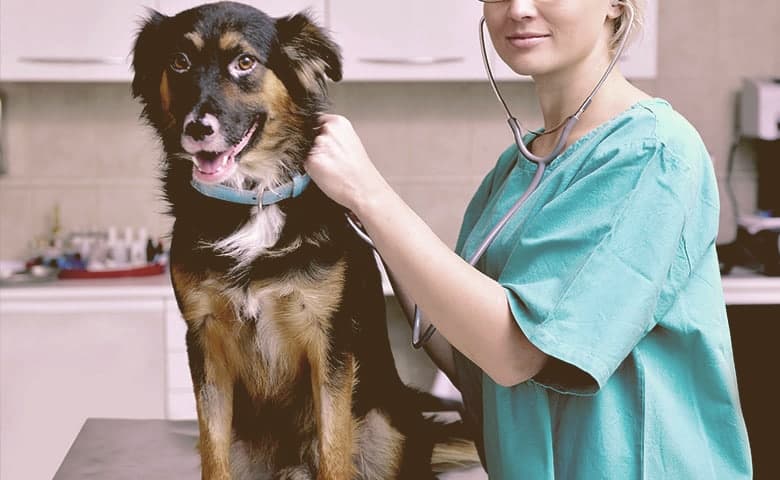
At-Home Treatments for Dog Diarrhea
There are several simple steps you can take at home to stop your dog’s diarrhea if you have a primarily healthy animal. My sister’s dog has lots of underlying issues, so every time she gets diarrhea, they feel like they need to take her in, but my dog is an overall healthy creature, so she doesn’t go to the vet for diarrhea unless other symptoms come up. It’s your call.
The first step in fixing the diarrhea problem is to avoid giving your dog food for 12 hours. That doesn’t mean you take away the water dish, and you’d probably want to start the 12 hours in the evening if possible so that your dog isn’t as likely to notice that there’s no bowl ready for them. Once the 12 hours are up, you’ll feed them only a bland, fat-free diet until the stools are normal.
Using the method we described above, you’ll usually see a return to normal in about 72 hours. Although some vets will tell you that rice and beef are a good option for the bland diet, you may want to consider ground turkey or chicken because of the much lower fat content. You should also consider sweet potato or pumpkin versus rice as they tend to digest better overall.
You can also offer your dog a light soup instead if their diarrhea was more severe or if they had other symptoms along with it.
Add Balance Back Into the Gut
Once your dog’s stools are healthy again, you’ll want to get their gut bacteria back in check. The best way to do this is by using prebiotics and probiotics. Just like humans need the right balance of gut bacteria for optimal health, dogs do as well. There are plenty of dog-specific probiotics on the market, and you can also feed your dog foods that act as prebiotics or have them built-in.
Scientists are still in the first stages of studying probiotic use in animals, but there is plenty of anecdotal evidence that these supplements work well. There is even a study out of Ireland that suggests that probiotic use shortens the duration of diarrhea when it occurs and reduces the risk of dogs needing antibiotics.
You should know that antibiotics and steroids that vets give to dogs to stop diarrhea aren’t solving the problem, but instead covering up the symptoms. They are also huge culprits of killing good gut bacteria and causing additional issues down the road with both diarrhea and lowered immunity.
We’d recommend avoiding antibiotics and steroids for diarrhea unless a bacterial infection is the definite cause of your dog’s problems. Of course, you should always seek veterinarian advice before making a final decision. It’s a good idea to talk to more than one vet, if possible, before making your ultimate decision.
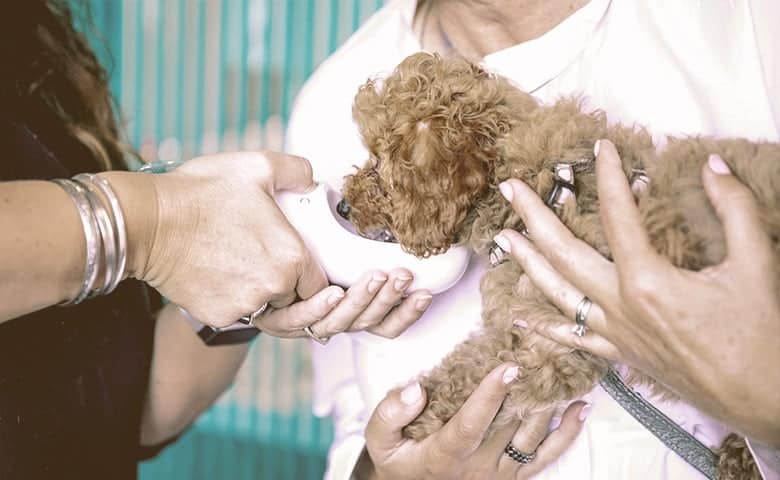
Slippery Elm
Herbs are an excellent option for helping your dog to feel better, but you should only use them if you’re aware of how to dose and how they work in your animal. Slippery elm is safe for all dogs, including puppies and geriatric dogs. You should use a half teaspoon for every 10 pounds of your dog’s body weight. For a 50 pound dog, that’s 25 teaspoons or just over half a cup.
You can use slippery elm along with the bland diet you’re feeding your dog during their recovery period. You should not give your dog dosages after three days, but instead, call your vet for an appointment if their diarrhea hasn’t cleared up.
The Many Colors of Poop: What is Your Dog’s Feces Telling You?
Let’s be honest here, no one wants to go out and take a hard look at their dog’s poop, but sometimes it’s a good idea to ensure that your dog is healthy. Medical professionals have used stool samples as a method for diagnosing illnesses in all species for a century or more, and that’s because it works well. So sometimes we need to get down and dirty for our dog’s health.
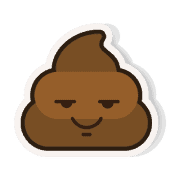
Brown Stool
A healthy dog of any age will produce a dark brown, hard stool. It should look like chocolate all over without spots or streaks.
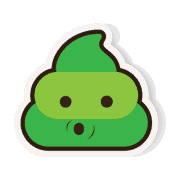
Green Stool
If your dog is eating a lot of grass, then they might end up with green stool. Generally speaking, when a dog wants to eat a ton of grass, they are having digestive issues. Look at what you’re feeding them, their stress level, and their toys to ensure nothing visible is causing the upset.
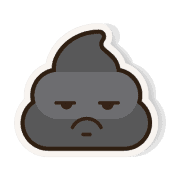
Black or Tarry Stool
A black or maroon stool can be bad news for your dog. We often associate these stools with bleeding in the stomach or small intestines. You’ll want to seek medical advice immediately if you see this type of stool.
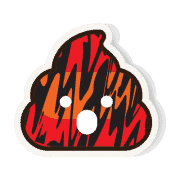
Red Streaks
If you see bright red streaks, there could be bleeding in your dog’s lower GI tract. Bleeding could indicate a serious issue, so if you see more than just a single streak, you’ll want to contact your vet immediately.

Yellow Stool
Problems with the gallbladder, liver, or pancreas can cause your dog’s stool to appear yellow. If you see a couple of stools in a row with a yellow tone, then you should call your vet to make an appointment to have testing done.
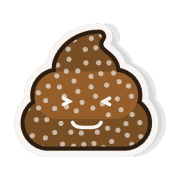
White Spots
Ah, the dreaded white spots. These spots often indicate that your dog has some type of worms. You’ll want to get him into the vet as soon as possible so you can take care of those worms before they cause major health issues.
The Scale of Stools
Vets often use a scale of one to seven to rate dog poop. One indicates hard, small pellets, and seven shows a formless puddle. If your dog’s diarrhea is a number seven on the scale, you’ll want to get him into the vet as soon as possible. The ideal number on the scale is a two (ironic, we know!), which indicates that the stool isn’t too hard and is the ideal shape.

How to Safely Clean Up Doggy Diarrhea
Now that you know all about how diarrhea affects your dog and what to do about it let’s talk about the part that affects you: the cleanup. It’s no fun to clean up a pet’s accident, especially if you have a carpet or a rug. Cleaning up thoroughly and safely is vital to your health and the health of your pet(s) and family.
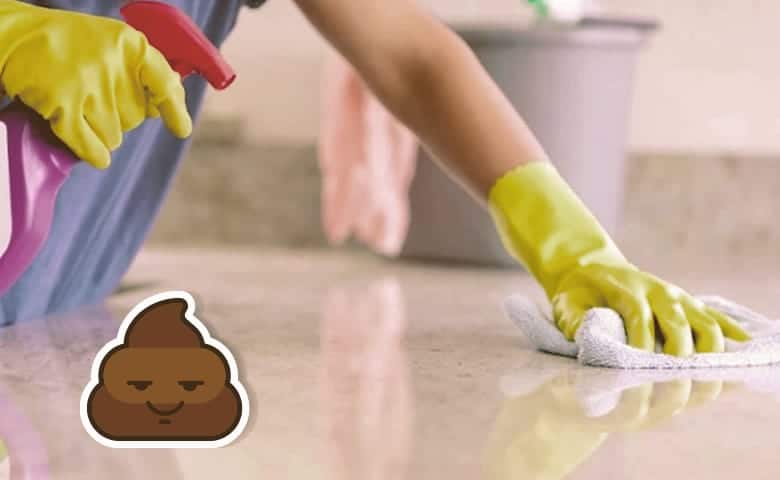
Gather Your Supplies
If you have a dog, it’s a good idea to keep a doggy accident cleanup kit around just in case. Accidents happen, and as we discussed earlier, diarrhea will occasionally occur, no matter how hard you try to prevent it. Your cleanup kit should include the following supplies:
- Gloves
Preferably disposable latex or nitrile varieties - Cleaning solution
You can opt for a store-bought enzyme cleaner or make your own with vinegar and baking soda - Paper towels or baby wipes
- Paper plates
- Plastic bags
- Vacuum or steam cleaner
The Cleanup Process
As soon as you see the mess, you should take your dog outside to ensure any additional messes go in the grass, and help your dog to feel better with fresh air. Once that’s handled, you can start to clean.
If the mess is still wet– which is ideal– you’ll want to scoop as much of the mess up and into the plastic bag as possible. This step is where the paper plate comes in. If you use a plate or two like a broom and dustpan, you’ll be less likely to push the mess around and get it on more of your precious flooring.
Scrape as much of the mess up as you can without pushing it further down into carpet fibers or between cracks in the floor. Next, you’ll want to blot up any additional wetness with a paper towel. Always avoid rubbing the spot, as they could lead to diarrhea getting trapped in your carpet fibers.
Once you’ve gotten up as much of the mess as you can, spray your cleaning solution and blot some more. This point is also the time when you can break out your wet vacuum or steam cleaner if you have one handy to pull up residual feces.
Once it looks like the mess is gone, let the spot completely dry. You may find that you have to repeat the process a few times to get it totally out if you don’t have a steam cleaner, but it’s worth the work to ensure a healthy household. Block off the area so that your dog doesn’t track through it, and no children have access until you’re sure the mess is completely gone.
In Summary
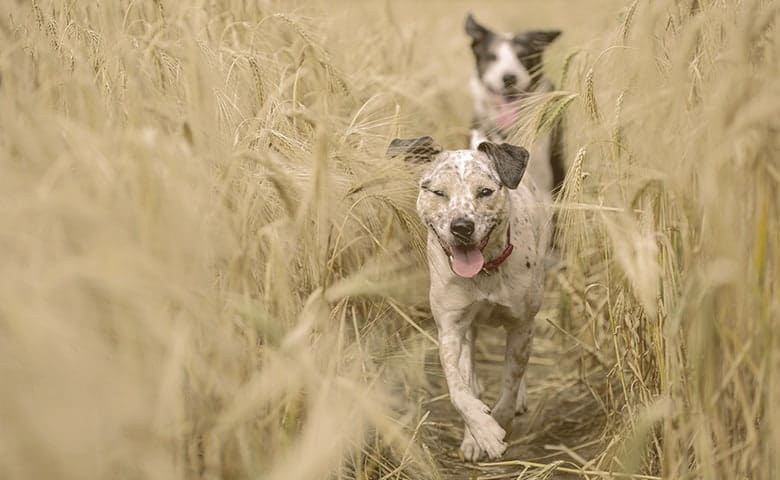
Diarrhea is an unfortunate part of owning a dog, but it’s a reality that all dog owners have to live with at one time or another. Luckily there are plenty of ways to keep the frequency of doggy GI issues down, like feeding your dog a healthy and raw diet, giving them probiotics and prebiotics regularly, following directions when switching your dog’s food, and avoiding bones as toys.
Now that you know what to look for when your dog develops diarrhea as a sign that he needs to see a veterinarian versus treating him at home, you’re well equipped to handle the situation. Remember that mild diarrhea in a healthy dog will usually only require a short spell of fasting and a few days of a bland diet. You should see symptoms clear up in about 72 hours.
If you keep an eye on your dog’s stool regularly, you’ll have an even better chance of catching severe issues before diarrhea hits. Make sure it’s chocolate brown and a solid, but not hard, consistency to ensure your animal’s health and wellbeing.
Finally, when you find yourself with a mess on your hands, especially on a carpeted floor, make sure you have supplies ready to clean up the mess as soon as possible. Put your dog outside to eat grass or get fresh air, and go right in to clean up with either an enzyme cleaner or a DIY mixture of white vinegar and baking soda.
Dog diarrhea isn’t a fun topic, but it’s an essential one for dog owners to understand. The health and happiness of your pup depend on your ability to respond correctly to their GI needs and beyond and understand a little more about diarrhea, and its causes will undoubtedly help get you to that end.

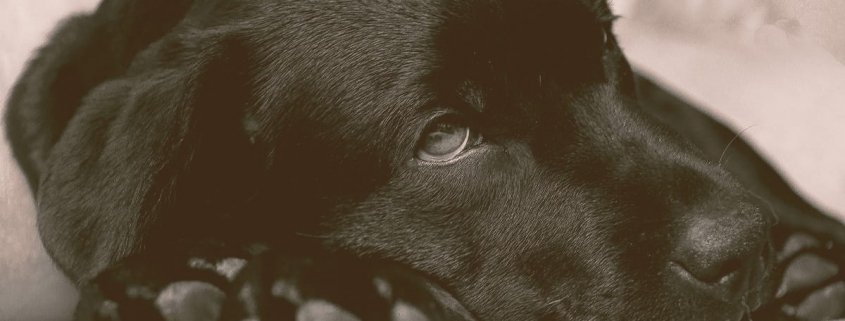

Leave a Reply
Want to join the discussion?Feel free to contribute!